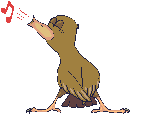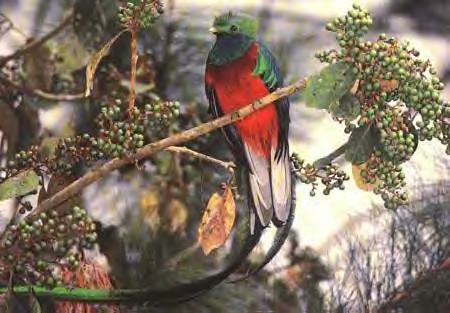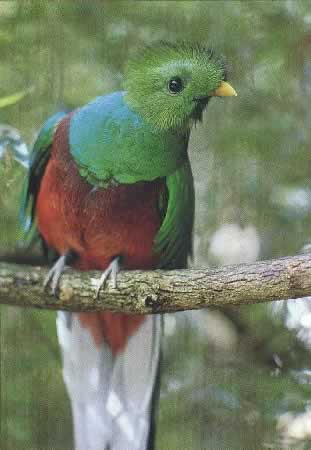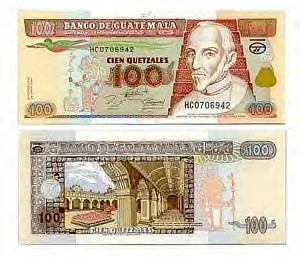|
|
Canku Ota |
|
|
(Many Paths) |
||
|
An Online Newsletter Celebrating Native America |
||
|
November 29, 2003 - Issue 101 |
||
|
|
||
|
How the Quetzal Became the King of Birds |
||
|
a Mayan Story |
||
|
Long ago, In Maya Land flowers. birds, trees butterflies and mammals appeared in other colors and shapes than those of today. Halach-Uinic, the Great Spirit guarded over all the Maya World. His will was law. One day be grew tired of the constant chatter and fighting among the birds. At a meeting in the center of the forest, he announced that the birds must choose a king to keep peace.
Then the wild turkey, Cutz, strode into the circle and gobbled, "There's no doubt that I should be king because I'm the biggest and strongest bird. With my size and strength, I can stop fights and also defend any bird. You need a powerful king. I'm the one!" And so, throughout the day various birds displayed their qualities. The only one that kept quiet was Kukul, the quetzal. This bird was very ambitious and proud. He had elegant manners and a graceful body, but his plumaged was shabby. Kukul thought it would be impossible to be chosen as king while he was dressed so poorly.
It was a tempting offer, yet the roadrunner did not feel too eager to part with his plumage. Kukul kept persuading and assuring Xtuntun of his integrity and fine intentions. He painted bright visions of the riches to come. At last, he convinced his trusting friend.
Swinging his exquisite 4-foot tail in an arc, the bold bird promenaded into the circle where the birds of Maya Land were congregated. His entrance caused a hush. Then cries of "Bravo," "Hurrah," "Oh" and "Ah" filled the forest. Halach-Uinic was very pleased with the miraculous change from the quiet, drab bird to this radiant, proud creature before him. Calling the audience to order, the Great Spirit declared: "I name the quetzal to be king or the birds."
Finally, they all flew home and left Kukul to begin his new duties. He found himself extremely busy so he never had time to return the borrowed feathers. In fact, he forgot all about his promise to the roadrunner. One day, a group of birds noticed that the roadrunner had not appeared in several days. In fact, no one had seen him since the great election. They began to suspect Kukul of some trick, so they organized a search. Deep into the forest behind a bush, they found Xtuntun-kinil, naked, trembling with cold and almost dead of hunger. Quickly, the birds gave him some black (honey drink) to help him recover.
Print and Color Your Own Quetzal |
|
|

 Of
course, each bird thought it possessed the best qualifications.
Col-pol-che, the cardinal sang, "Look at me. No one else is
bright red and so beautiful. All the birds admire me. I should he
king." And he strutted in front of the impressed bird audience,
fluttering his wings and raising his crest.
Of
course, each bird thought it possessed the best qualifications.
Col-pol-che, the cardinal sang, "Look at me. No one else is
bright red and so beautiful. All the birds admire me. I should he
king." And he strutted in front of the impressed bird audience,
fluttering his wings and raising his crest. X-col-col-chek,
the tropical mockingbird, trilled out, "I'm the only bird with
such a lovely voice. Everyone listens to me." Enlarging his
throat, X-col gave a short performance of enchanting and complicated
melodies. This was a tremendous sensation among the birds and went
far in convincing them that the mockingbird should be king.
X-col-col-chek,
the tropical mockingbird, trilled out, "I'm the only bird with
such a lovely voice. Everyone listens to me." Enlarging his
throat, X-col gave a short performance of enchanting and complicated
melodies. This was a tremendous sensation among the birds and went
far in convincing them that the mockingbird should be king. After
thinking carefully he flew over to his friend, Xtuntun-kinil, the
roadrunner. "I want to make you a proposition, my dear friend,"
he said. "Your feathers are so handsome as any bird's here,
but you are too busy with your work as messenger of the roads to
become king. Also, I don't think you posses quite the flair and
sophistication that is necessary for this job. I'm afraid I can't
loan these qualities to you, but you could loan me your feathers
just for this occasion. After I'm elected king, I'll share the wealth
and honors with you."
After
thinking carefully he flew over to his friend, Xtuntun-kinil, the
roadrunner. "I want to make you a proposition, my dear friend,"
he said. "Your feathers are so handsome as any bird's here,
but you are too busy with your work as messenger of the roads to
become king. Also, I don't think you posses quite the flair and
sophistication that is necessary for this job. I'm afraid I can't
loan these qualities to you, but you could loan me your feathers
just for this occasion. After I'm elected king, I'll share the wealth
and honors with you." One
by one, the feathers disappeared from Xtuntsun's body and the clever
quetzal adjusted them to his own. Within minutes, they had multiplied
and grown so that the ambitious bird was attired in the most splendid
costume imaginable. Kukul's tail hung in a sweeping curve of jade
green plumes. His body shimmered with soft, iridescent hues of blue
and green like the Maya sky and jungle. His breast blazed with the
colors of a tropical sunset. And his beak turned yellow as corn.
One
by one, the feathers disappeared from Xtuntsun's body and the clever
quetzal adjusted them to his own. Within minutes, they had multiplied
and grown so that the ambitious bird was attired in the most splendid
costume imaginable. Kukul's tail hung in a sweeping curve of jade
green plumes. His body shimmered with soft, iridescent hues of blue
and green like the Maya sky and jungle. His breast blazed with the
colors of a tropical sunset. And his beak turned yellow as corn. A
loud applause followed this announcement and each bird hopped over
to the quetzal with congratulations.
A
loud applause followed this announcement and each bird hopped over
to the quetzal with congratulations. That
is why today the roadrunner's feathers are so oddly colored and
varied in pattern, and why he always watches the Maya roads. He
is still searching for the quetzal that took away his plumage and
still running anxiously in front of travelers asking, "Puhuy?
Puhuy?"
That
is why today the roadrunner's feathers are so oddly colored and
varied in pattern, and why he always watches the Maya roads. He
is still searching for the quetzal that took away his plumage and
still running anxiously in front of travelers asking, "Puhuy?
Puhuy?" The
Quetzal is a bird which can be found in the mountain or "cloud"
rain forest of Central America and throughout Amazonia. It is described
by Roger Tory Peterson and Edward Chalif in their book, Field Guide to
the Birds of Mexico, as "the most spectacular bird in the New World".
The bird's body measures about 14 inches in length, about the size of
a pigeon. However, it has tail feathers which can extend as long as three
feet. Both the male and the female are an iridescent emerald and golden
green with tail feathers in iridescent blues and greens with white undertails.
The green camouflages them in the rain forest. The male has a head crest
and red breast feathers with a white undertail. The females are duller
and have fewer red breast feathers and short tail plumes. The Quetzal
is truly a splendid bird.
The
Quetzal is a bird which can be found in the mountain or "cloud"
rain forest of Central America and throughout Amazonia. It is described
by Roger Tory Peterson and Edward Chalif in their book, Field Guide to
the Birds of Mexico, as "the most spectacular bird in the New World".
The bird's body measures about 14 inches in length, about the size of
a pigeon. However, it has tail feathers which can extend as long as three
feet. Both the male and the female are an iridescent emerald and golden
green with tail feathers in iridescent blues and greens with white undertails.
The green camouflages them in the rain forest. The male has a head crest
and red breast feathers with a white undertail. The females are duller
and have fewer red breast feathers and short tail plumes. The Quetzal
is truly a splendid bird.  The
Quetzal is also the most sacred symbol of the Mayas. Eighty percent of
the present day inhabitants of Guatemala and the neighboring Mexican states
of Yucatan, Quintano Roo, and Chiapas are descendants of the ancient Mayas.
To the ancient Mayas the Quetzal symbolized freedom and wealth. Freedom,
because a Quetzal will die in captivity; wealth, because the Mayas were
traders, and quetzal feathers along with jade were their most sought after
treasures. These were traded by the Mayas as far north as the central
valley of Mexico and as far south as the Empire of the Incas (over three
thousand miles) an area that is about eight times the size of their home
territory.
The
Quetzal is also the most sacred symbol of the Mayas. Eighty percent of
the present day inhabitants of Guatemala and the neighboring Mexican states
of Yucatan, Quintano Roo, and Chiapas are descendants of the ancient Mayas.
To the ancient Mayas the Quetzal symbolized freedom and wealth. Freedom,
because a Quetzal will die in captivity; wealth, because the Mayas were
traders, and quetzal feathers along with jade were their most sought after
treasures. These were traded by the Mayas as far north as the central
valley of Mexico and as far south as the Empire of the Incas (over three
thousand miles) an area that is about eight times the size of their home
territory. Today
the male Quetzal appears on the Guatemalan flag, coat of arms, and stamps.
The name "quetzal" is also used as a monetary unit. One Quetzal
is equal to one U.S. dollar. Collectors value the older, rare silver coins
at $400.
Today
the male Quetzal appears on the Guatemalan flag, coat of arms, and stamps.
The name "quetzal" is also used as a monetary unit. One Quetzal
is equal to one U.S. dollar. Collectors value the older, rare silver coins
at $400.